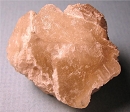
|
| Witherite |
Chemical
Formula |
BaCO3 |
Species |
Carbonates |
Crystal
System |
Orthorhombic |
Mohs
Scale |
3 |
Specific
Gravity |
4.3 |
Color |
Colorless, white, pale gray, with possible tints of pale yellow, pale brown, or pale green |
Streak |
White |
Luster |
Vitreous, Resinous |
Refractive
Index |
n = 1.529 n = 1.676 n = 1.677 |
Diaphaneity |
Transparent, Translucent |
Cleavage |
Distinct/GoodOn distinct; on imperfect. Possibly also on and . |
Fracture |
Irregular/Uneven |
| Crystal Habit:Striated short prismatic crystals, also botryoidal to spherical,columnar fibrous, granular, massive. |
| Geological Setting:Low-temperature hydrothermal veins. |
Witherite is a barium carbonate mineral, BaCO
3, in the aragonite group. Witherite crystallizes in the orthorhombic system and virtually always is twinned. The mineral is colorless, milky white, grey, pale yellow, green, to pale brown. The specific gravity is 4.3, which is high for a translucent mineral. It fluoresces light blue under both long and short-wave UV light, and is phosphorescent under short-wave UV light.
Witherite forms in low-temperature hydrothermal environments. It is commonly associated with fluorite, celestine, galena, barite, calcite and aragonite. Witherite occurrences include: Cave-in-Rock, Illinois, USA; Settlingstones Mine Northumberland, Alston Moor, Cumbria, Anglezarke, Lancashire and Burnhope, County Durham, England; Thunder Bay area, Ontario, Canada, Germany and Poland (Tarnowskie Góry and Tajno at Suwa?ki Region).
Witherite was named for William Withering (1741-1799) an English physician and naturalist.
Risk to human health
The 18th century naturalist Dr. Leigh recorded its lethal effects after the death of a farmer's wife and child. James Watt Jnr. experimented with the mineral on animals and he recorded the same lethal properties. Until the 18th century farmers at Anglezarke used the mineral as rat poison.
Industrial use
Another experiment was conducted by Josiah Wedgwood who used it in his 'Jasper ware'; the mineral had previously been considered as worthless.


 YueGongAnBei 44051102000467
YueGongAnBei 44051102000467


 |
|